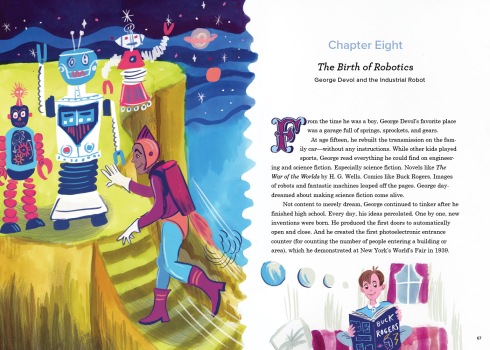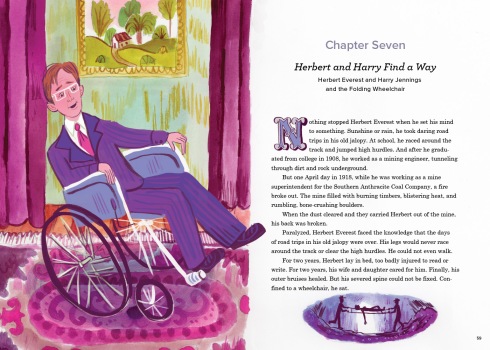by Vivian Kirkfield
Ten years ago, I skirted the shadows of Tara’s 2011 PiBoIdMo (now Storystorm) Challenge. I walked away with a notebook filled with 30 ideas and a thirst for more. Two months later, I hopped aboard the first year of Julie Hedlund’s 12×12 Picture Book Challenge and wrote 12 picture book manuscripts. I got in the habit of gathering ideas from wherever they came and turning them into picture book stories. And that habit came in handy in the fall of 2017. I sold a manuscript to Ann Rider at HMH and she didn’t want just that manuscript—she wanted NINE! She wanted to create a compilation book about inventions that changed the way the world moves. My deadline was May 1, 2018—which gave me nine months to hand in nine submission-ready narrative nonfiction picture book biographies.
The idea for the first story actually came from my sister who had told me about a friend of a friend who was the granddaughter of the founder of the Greyhound Bus Company. It sounded like a fascinating story—my curiosity was piqued—and I dug deep into finding out more. After writing the rough draft and many rounds of revision and critique group feedback, my agent submitted it and we got interest from Ann. But the editor wasn’t sure if Eric and the bus were strong enough/popular enough to be a stand-alone picture book. Ann had an idea…would I be willing to write several more stories, similar in structure and tone, about the invention or creation of other things that move?

My answer, of course, was YES!
The editor wanted all the stories to include:
- Engaging opening lines.
- Child main character who has a dream/goal.
- AH-HA moment.
- Fun language/great rhythm/excellent pacing.
- Legacy paragraph that shows how the invention impacts us today.
- Satisfying ending that echoes the opening lines.
I got down to business. First, I made a list of vehicles, like the car and the train. I already had a manuscript about the invention of the hot-air balloon—maybe I could tweak it to fit this collection. But Ann also wanted me to think outside the box of things that move. Maybe a robot, she suggested. And I wondered, who invented the first robot? Early on, robots were part of science fiction—in the writings of H.G. Wells and Isaac Asimov. I dug deeper. I discovered the story of a young boy of fifteen who rebuilt the transmission of his family’s car—without an instruction manual. When he graduated from high school, he designed the first automatic doors. He engineered the first photoelectric entrance counters which were demonstrated at the 1939 World’s Fair. And he built the first robotic, a mechanical arm used at a General Motors factory in 1961 to weld car parts. His name? George Devol, the Father of Robotics. But I’d never heard of him and perhaps most of you haven’t either. I guess that’s another reason I write these narrative nonfiction biographies—I’m passionate about sharing the lives of these ordinary people who have done extraordinary things. I’m hoping to spark the curiosity of young readers to inspire them to create their own magic.

Another out-of-the-box moving invention was the folding wheelchair that opened doors, both literally and figuratively, for mobility challenged individuals. More digging revealed that this inventor had been a high hurdler in college. But after becoming a mining engineer, Herbert Everest broke his back in a mining accident. Paralyzed, but unwilling to forego his beloved road trips, Herbert and a mechanical engineering buddy, Harry Jennings, brainstormed until they came up with a wheelchair design that would allow the chair to fit in a car. Although there was a lot of information about their wheelchair company, there was almost nothing about Herbert’s early life. Where could I find that information? I consulted the census, I studied the online documents from the Colorado School of Mines where Herbert attended college, and I reached out to the special collections’ librarian at the downtown library in Oklahoma City where Herbert lived for many years. Lisa Bray was unbelievably helpful and I learned enough so that I could craft a credible story of Herbert’s early years.

The last chapter in this compilation book is one of my favorites. I know I wanted at least one water vehicle. But who invented the first boat? Canoes and kayaks have been around since before 8000 BCE. There was no way I would be able to pin down an AH-HA moment or delve into the childhood of those visionaries. So again, I tried to think outside the box. I googled ‘firsts in shipbuilding’ and I was lucky. Up popped the name of Raye Montague, who led the team of naval engineers in 1970 to create the first computer-generated ship design. More luck came my way when I uncovered several taped interviews she had given and I was able to hear her story, from childhood on, in her own voice.

My journey with FROM HERE TO THERE: Inventions That Changed the Way the World Moves, illustrated by the brilliant Gilbert Ford, has definitely been a labor of love—nine months, nine stories—and I think the journey is just beginning. But I’d like to leave you with a quote from Lisa Bray, that amazing Oklahoma City librarian, because it speaks to what the Storystorm Challenge is all about, and to what we, as writers, need to keep close to our hearts as we step into 2021 and craft stories that will engage young readers:
”There are interesting stories everywhere you look, and one doesn’t have to be famous to have a good story to tell.”

Writer for children—reader forever…that’s Vivian Kirkfield in five words. Her bucket list contains many more words—but she’s already checked off skydiving, parasailing, and visiting kidlit friends all around the world. When she isn’t looking for ways to fall from the sky or sink under the water, she can be found writing picture books in the picturesque town of Bedford, New Hampshire. A retired kindergarten teacher with a masters in Early Childhood Education, Vivian inspires budding writers during classroom visits and shares insights with aspiring authors at conferences and on her blog where she hosts the #50PreciousWords International Writing Contest and the #50PreciousWordsforKids Challenge. Her nonfiction narratives bring history alive for young readers and her picture books have garnered starred reviews and accolades including the Silver Eureka, Social Studies Notable Trade Book, and Junior Library Guild Selection.
 To connect with Vivian and learn more about her books:
To connect with Vivian and learn more about her books:
Website: www.viviankirkfield.com
Facebook: www.facebook.com/viviankirkfield
Twitter: www.twitter.com/viviankirkfield
Linkedin: www.linkedin.com/in/viviankirkfield
Instagram: www.instagram.com/viviankirkfield

Vivian is offering a 60-minute Zoom meeting to chat about a specific manuscript or anything else writer-related.
Leave one comment below to enter.
You’re eligible to win if you’re a registered Storystorm participant and you have commented once below.
Source : Storystorm 2021 Day 2: Vivian Kirkfield Creates a Compilation Book













